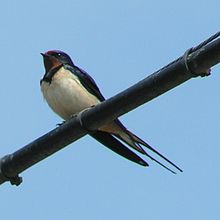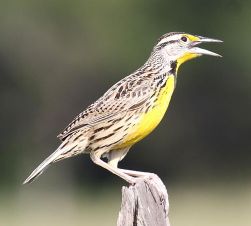At the spring meeting of the Committee on the Status of Endangered Wildlife in Canada (COSEWIC) held in Charlottetown, PEI May 1-6, 2011, Threatened status was recommended for two more species of songbirds – Eastern Meadowlark and Barn Swallow. The addition of these two common species draws further attention to the plights faced by grassland birds and aerial insectivores.
 The Barn Swallow Hirundo rustica is one of the world’s most widespread and common landbird species. However, like many other species of birds that specialize on a diet of flying insects, this species has experienced very large declines that began somewhat inexplicably in the mid to late 1980s in Canada. Its Canadian distribution and abundance may still be greater than prior to European settlement, owing to the species’ ability to adapt to nesting in a variety of artificial structures (barns, bridges, etc.) and to exploit foraging opportunities in open, human-modified, rural landscapes. While there have been losses in the amount of some important types of artificial nest sites (e.g., open barns) and in the amount of foraging habitat in open agricultural areas in some parts of Canada, the causes of the recent population decline are not well understood. The magnitude and geographic extent of the decline are cause for conservation concern. Their range covers every Canadian province and territory.
The Barn Swallow Hirundo rustica is one of the world’s most widespread and common landbird species. However, like many other species of birds that specialize on a diet of flying insects, this species has experienced very large declines that began somewhat inexplicably in the mid to late 1980s in Canada. Its Canadian distribution and abundance may still be greater than prior to European settlement, owing to the species’ ability to adapt to nesting in a variety of artificial structures (barns, bridges, etc.) and to exploit foraging opportunities in open, human-modified, rural landscapes. While there have been losses in the amount of some important types of artificial nest sites (e.g., open barns) and in the amount of foraging habitat in open agricultural areas in some parts of Canada, the causes of the recent population decline are not well understood. The magnitude and geographic extent of the decline are cause for conservation concern. Their range covers every Canadian province and territory.
 The Eastern Meadowlark Sturnella magna is a ground-nesting grassland specialist that has seen major changes in its population size and breeding range since European settlement. Most of its native prairie habitat had fallen to the plough by the end of the 19th century. However, these habitat losses were effectively counter-balanced by the provision of large amounts of surrogate grasslands (primarily pastures and hayfields) as a result of the widespread conversion of eastern deciduous forests to agricultural land. The species initially responded with expansions in its breeding range (primarily eastward). Since the mid 20th century, however, the amount and quality of surrogate grasslands across its range have declined. Although the species’ population is still relatively large, it has been undergoing persistent rangewide declines. These declines are believed to be driven mostly by ongoing loss and degradation of grassland habitat on both the breeding and wintering grounds, coupled with reduced reproductive success resulting from some agricultural practices. Canadian range is Ontario, Quebec, New Brunswick and Nova Scotia.
The Eastern Meadowlark Sturnella magna is a ground-nesting grassland specialist that has seen major changes in its population size and breeding range since European settlement. Most of its native prairie habitat had fallen to the plough by the end of the 19th century. However, these habitat losses were effectively counter-balanced by the provision of large amounts of surrogate grasslands (primarily pastures and hayfields) as a result of the widespread conversion of eastern deciduous forests to agricultural land. The species initially responded with expansions in its breeding range (primarily eastward). Since the mid 20th century, however, the amount and quality of surrogate grasslands across its range have declined. Although the species’ population is still relatively large, it has been undergoing persistent rangewide declines. These declines are believed to be driven mostly by ongoing loss and degradation of grassland habitat on both the breeding and wintering grounds, coupled with reduced reproductive success resulting from some agricultural practices. Canadian range is Ontario, Quebec, New Brunswick and Nova Scotia.
Jon McCracken, BSC’s Director of National Programs and co-chair of COSEWIC’s Bird Species Specialist Committee, said that, “Although the meadowlark and the Barn Swallow are still common, even common species require conservation attention when population declines are severe, persistent, and pervasive.” Still, he is optimistic. “Unlike other species at risk that are now rare, there’s still time to develop the kinds of meaningful conservation actions that are needed for meadowlarks and Barn Swallows.”
At the same meeting, COSEWIC upheld its decisions on the status of four other birds that had been assessed 10 years previously:
- Henslow’s Sparrow Ammodramus henslowii, Endangered
In Canada, this species occurs sporadically in Ontario and Quebec. Its Canadian population is extremely small, ranging from 0 to 25 individuals depending on the year. Populations in adjacent parts of the U.S., which are a likely source of birds for Canada, are declining. Habitat loss is ongoing for this species. Range Ontario and Quebec. Designated Threatened in April 1984. Status re-examined and designated Endangered in April 1993. Status re-examined and confirmed in November 2000 and May 2011.
- King Rail Rallus elegans, Endangered
This large member of the rail family is associated with marshes of various description – especially those that are large and relatively complex. Its breeding range extends from southern Ontario through much of the eastern U.S. In Canada, precise information on the population size, population trend, and breeding distribution of this rare and secretive species is somewhat limited. Nevertheless, the best available evidence indicates that the Canadian population remains small (fewer than 100 individuals). The major threat is degradation of high-quality marsh habitats across its range. Range Ontario. Designated Special Concern in April 1985. Status re-examined and designated Endangered in April 1994. Status re-examined and confirmed in November 2000 and in May 2011.
- Barrow’s Goldeneye Bucephala islandica, Eastern Population Special Concern
This population is found only in eastern regions of Canada. The population is small, but has been relatively stable over the last 10 years. Despite recent improvements in protection, threats from loss and degradation of forested habitats, in particular, are ongoing.Range Quebec and The Maritimes. Designated Special Concern in November 2000. Status re-examined and confirmed in May 2011.
- Long-billed Curlew Numenius americanus, Special Concern
In Canada, this large shorebird breeds in British Columbia, Alberta and Saskatchewan. Limited survey evidence suggests that the population has not changed significantly over the last 10 years, but there is anecdotal evidence suggesting regional declines. Historically, the extent and quality of its habitat has been significantly reduced by the conversion of native grasslands to agricultural crops and urban development. Ongoing threats include i) habitat loss and degradation from urban encroachment, cultivation of marginal native habitat and oil and gas development, ii) increased frequency of droughts associated with climate change, and iii) increase in predators associated with habitat fragmentation. Range British Columbia, Alberta and Saskatchewan. Designated Special Concern in April 1992. Status re-examined and confirmed in November 2002 and May 2011.
Sources:
Committee on the Status of Endangered Wildlife in Canada
Photos: Wikipedia



Pingback: Wednesday Wings: Bitty Barn Swallows | Bird Canada
My birding friends and myself were astonished when Barn Swallows were put on the threatened list. They have been one of the most common birds around in the past, but now we’re looking for them more carefully. Glad to know you’re providing some good housing for swallows!
Noted that Barn Swallows are threatened, we have had nesting Barn Swallows in our area for a number of years, I build a number of birdhouses for the Tree Swallows and have had luck in raising over a dozen young.
Pingback: Lessons From an Indoor Cat « Fate & Folly
Pingback: Threatened « Prairie Birder